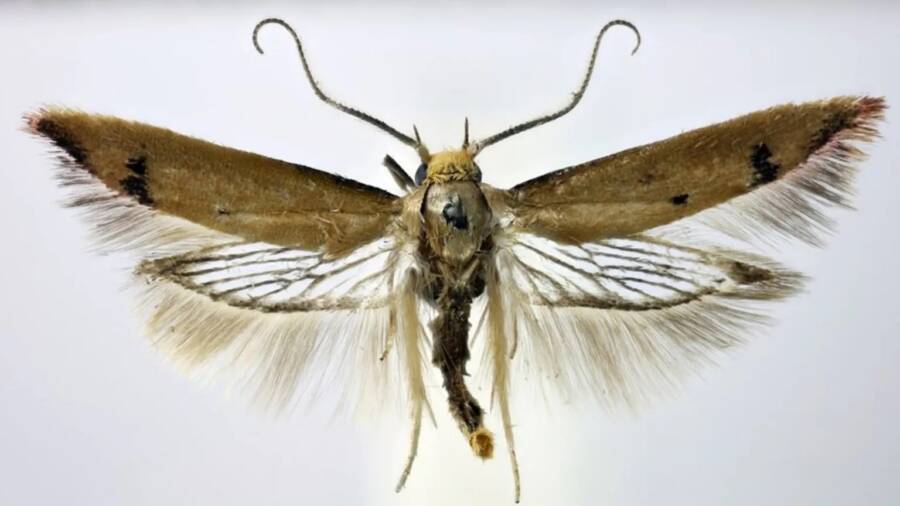DNA analysis showed that the new moth discovered in Ealing, West London was a perfect match for an unnamed species found in Western Australia in 1886.
David Lees / Museum of Natural HistoryBarbara Mulligan, the moth enthusiast who made the discovery.
Barbara Mulligan is something of a moth enthusiast, but when she opened one of her moth traps in 2021 to find a small brown moth she didn’t recognize, she knew she needed an expert opinion.
A native of Ealing, West London, Mulligan had no way of knowing that the little brown moth she had caught was a native of the Land Down Under, more than 9,000 miles away in Australia. Yet, that’s precisely what a newly released DNA analysis of the moth indicates, according to the Natural History Museum.
“What Barbara had found was an undescribed species,” said Mark Sterling, a scientific associate at the Natural History Museum who helped describe the new species. “She found this extraordinary moth which has somehow come over from Western Australia and established itself in three or four places in West London. And she is still the only person in the UK to have found it. This is a real coup for citizen science.”
When Mulligan was informed of the nature of her discovery, she told the BBC it was “a lovely surprise.”
Mulligan, a retired housing finance officer, has been catching and breeding moths since she was just 10 years old. After finding the first of this new moth species in local Walpole Park, Mulligan went on to find about 25 more specimens in various places across West London.
“One thing I never thought would ever happen was that I’d find a new species,” she said.

Mark Sterling / Trustees of Natural History MuseumThe moth species is native to Australia, but it was first identified from the specimens caught in West London.
When she sent the first moth off to the Natural History Museum, it found its way to Sterling, who works as part of the museum’s microlepidoptera unit — which looks after the tens of millions of moths in the museum’s collection.
After closely analyzing the new moth and describing its shape and anatomy, Sterling and the team were able to place it within the genus Tachystola, which are native to Australia. But it didn’t match any known species.
Fortunately, the museum was also trialling a state-of-the-art genetic technique at the same time. Known as “genome skimming,” this process can sequence a specimen’s genome in incredibly small pieces.
Using this technique, museum researchers compared a Tachystola hemisema specimen from Sydney with another unnamed specimen found in Western Australia in 1886.
“When the result came back we were amazed — gobsmacked in fact,” said David Lees, the senior curator for microlepidoptera at the Natural History Museum. “The sequence was practically identical.”
However, Lees noted that there was a “difference of 3.65 percent in the DNA barcode between the Western Australian specimen and the species described by Meyrick from Sydney, so that is the kind of level we would normally expect for a distinct species.”
That unidentified specimen from Western Australia did match the moths Mulligan found in Ealing, though.
As such, this newly recognized species was given the name Tachystola mulliganae, after Barbara Mulligan herself.
“It’s nice to think I’ll be forever remembered by a moth,” Mulligan said.
Still, it’s not entirely clear how this little moth made the journey from Western Australia all the way to a park in Ealing.
Lees and other researchers suggested it may have had something to do with plants being imported into the region, though this is still unconfirmed.
“These moths can feed on dead leaves, so they may be able to get through in leaf litter on plant pots and that kind of thing,” Dr. Lees said. “In fact, Barbara had originally noticed that there were some eucalyptus leaves around her in a neighbor’s garden in Ealing.”
So far, the team has been unable to find any of the moth’s larvae in Britain. Given that it has only been found in a total of four locations around London, though, it’s likely that the moth made the journey to Ealing relatively recently, as it would have spread further otherwise.
There is one other odd twist to this story: Mulligan had found her moth in Walpole Park — and the original specimen at the museum from Western Australia came from a district known as Walpole.
It’s most certainly a coincidence, but still, it almost feels as if this tale has come full circle.
After learning about the discovery of this moth, read about the moth discovered in Madagascar that has the longest tongue of any insect. Or, read about the Mothman — and the terrifying legends that accompany him.
https://allthatsinteresting.com/tachystola-mulliganae-moth




